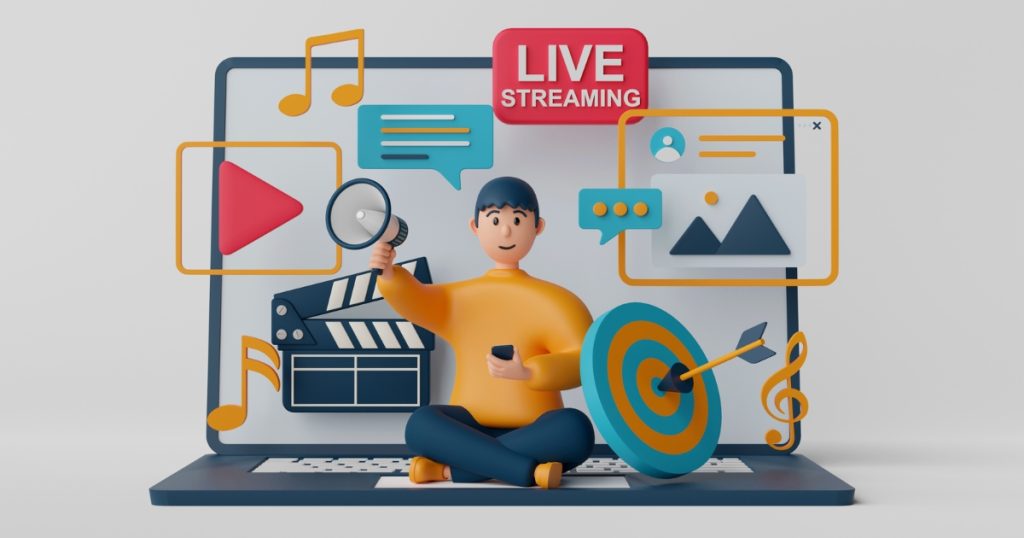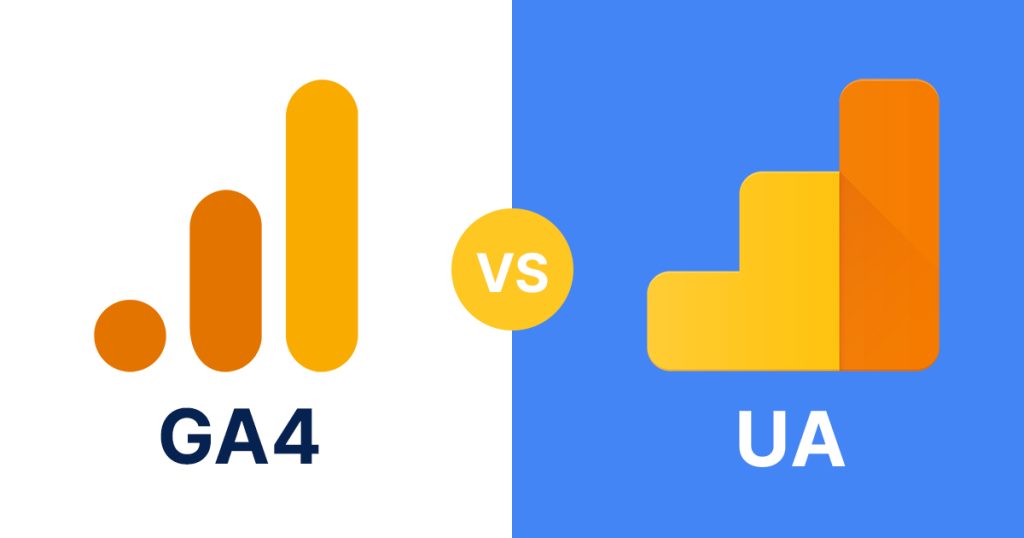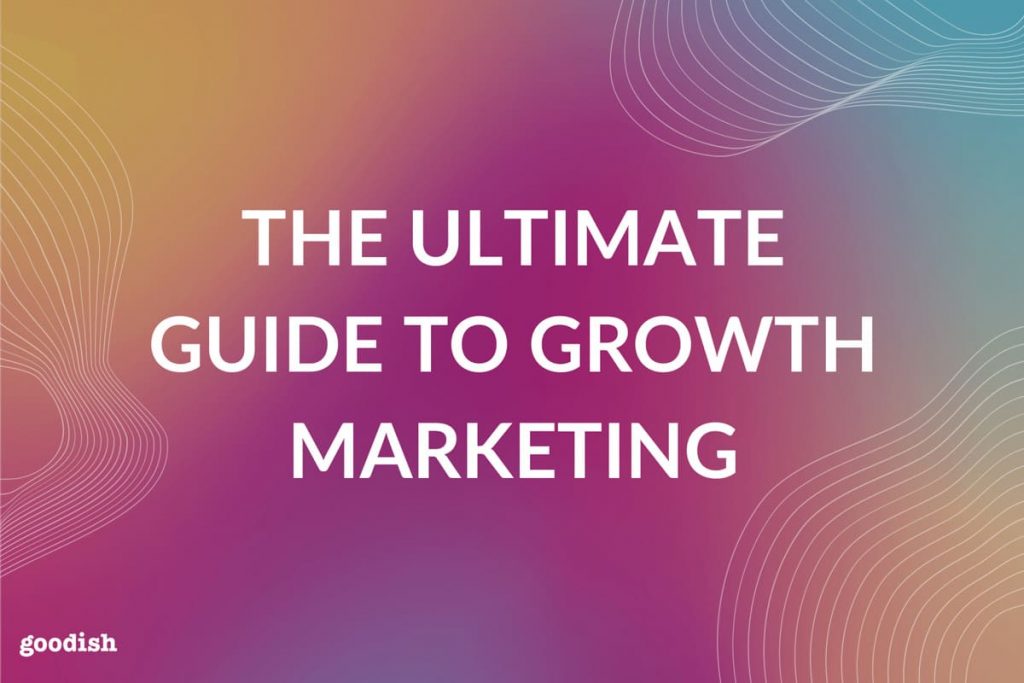For content creators, true success lies not just in creating visually appealing or compelling stories, but in deeply understanding their audience. It’s crucial to grasp what engages them, keeps them returning, and encourages sharing.
Google Analytics (GA4) emerges as a vital tool in this landscape. Offering insights into user behavior beyond mere clicks, it reveals motivations and preferences, pivotal for creating content that resonates and stands out online. Learning GA4 can be a strategic move for impactful content creation
Specializing in GA4, our agency partners with creators like you to fully leverage this powerful tool. Check out our services and see how we can help you better engage with your audience.
Table of Contents
1. Transitioning from Universal Analytics to GA4
2. Event Tracking Made Easy
3. Unified Cross-Platform Tracking
4. Improved Data Privacy Controls
5. Audience Building and Segmentation
6. Predictive Metrics and Analysis
7. Integration with Google Ads
8. Conversion Tracking and Attribution
9. Customizable Dashboards and Reports
10.GA4 for E-commerce
11. GA4 for Social Media Marketers
12. Conclusion
Transitioning from Universal Analytics to GA4
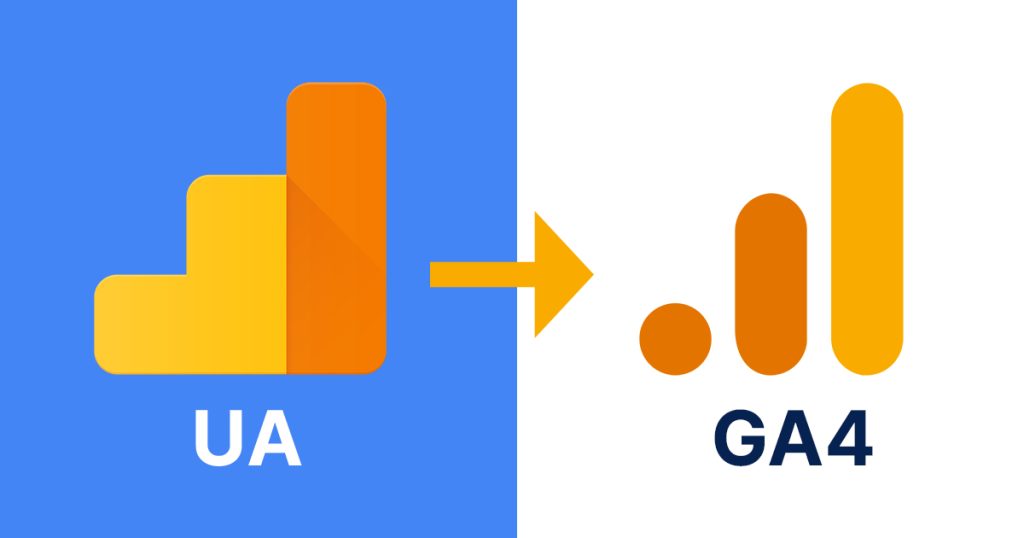
Even though the mandatory migration to Google Analytics 4 (GA4) was completed by July 1, 2023, the transition period is still a hot topic for content creators who are navigating the new landscape.
If you’ve recently made the switch or are still finding your footing, here’s what you need to know about moving from Universal Analytics (UA) to GA4.
Understanding the Change
GA4 represents a significant shift from UA, with a new interface, data model, and set of features designed for the privacy-first, multi-platform digital environment.
Unlike UA, GA4 focuses on user-centric data and cross-platform tracking, which aligns better with the way people interact with content across various devices and platforms today.
Data and Reporting Differences
One of the most crucial aspects of the transition is understanding how GA4 handles data differently.
For instance, GA4 uses an event-based data model which is more flexible than the session-based model in UA. This means that as a content creator, you’ll have to rethink how you measure engagement and conversions.
Learning New Features
GA4 introduces several new features, such as enhanced machine learning capabilities, which can predict user behavior and provide valuable insights into your audience.
Familiarizing yourself with these features will allow you to leverage predictive metrics, such as potential revenue from a segment of users who may purchase a product or subscribe to a service.
Adapting to the New Environment
With the transition, it’s essential to adapt your content strategy based on the insights GA4 provides. This might involve redefining your content KPIs, setting up new events and conversion goals, and understanding the new user engagement metrics.
Preserving Historical Data
Since UA is no longer active, making sure you have a strategy for accessing historical data is important.
While you can’t transfer data from UA to GA4, you can export your UA data for record-keeping and comparison purposes. It’s important to maintain this data to understand long-term trends and shifts in audience behavior.
Continuous Learning
The digital analytics field is always evolving, and so is GA4. Keep an eye on updates from Google and the analytics community. Engage with forums, webinars, and other educational resources to stay informed about best practices and new features.
Event Tracking Made Easy
If you’ve ever tried to figure out what people do when they visit your website or watch your videos, you know it can get pretty technical.
In the past, you might have needed to add special codes to your site just to see if someone clicked a button or downloaded a guide. But with GA4, things have gotten a lot easier.
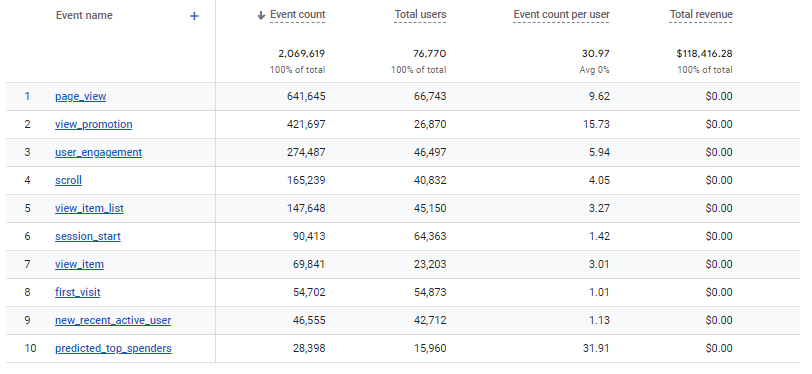
What’s New with Event Tracking?
Now, many basic interactions are tracked automatically. That means right out of the box, without any extra work, you can see if someone’s watching a video, downloading your content, or even scrolling through your page.
Custom Events for Deeper Insights
For the more unique actions that aren’t tracked automatically, GA4 lets you set up your own events without having to be a coding genius.
You can tell GA4 exactly what you want to keep an eye on, like if someone uses a specific feature on your app or if they’re interacting with a new section on your website.
Real-Time Feedback
One of the coolest things about GA4’s event tracking is that you can see what’s happening as it happens. This real-time feedback lets you quickly figure out if a new piece of content is a hit or if something on your site isn’t working the way it should.
Understanding Your Audience’s Actions
With GA4, you can get a clear picture of how people are interacting with your content. Are they just looking at it, or are they engaging with it? Do they stop watching your video halfway through, or do they watch it all the way to the end? This info can help you make better content that keeps people interested.
No More Guesswork
Before you might have had to guess which parts of your content were working well. But now, with easy event tracking, you can know for sure. You can see which buttons people click the most, which links they’re interested in, and even which words catch their attention.
Making Improvements
Once you know what your audience likes and what they don’t, you can start making changes. If you see that people love a certain type of post, you can make more like it. Or if you notice that nobody’s clicking on a particular link, maybe it’s time to try something different.
Unified Cross-Platform Tracking
Cross-platform tracking allows you to track a user’s interactions with your content across different devices and platforms. This means you can understand their behavior whether they’re on a mobile app, a desktop website, or a tablet.
Seamless Integration Across Devices
GA4’s tracking system is designed to provide a cohesive view of user interactions. This makes sure you see a complete story of how people use your content, not just bits and pieces.
Comprehensive Behavior Analysis
With this feature, you can analyze the user journey more accurately. You can see if users prefer certain content on mobile over desktop, or if they start an action on one device and complete it on another.
Strategic Content Placement
Knowing where your users are most engaged helps you place your content strategically. If your users tend to interact more with your app, you can focus your efforts there, ensuring your content is optimized for the best user experience.
Improved Data Privacy Controls
Privacy is a big deal these days, and everyone wants to know that their information is safe. GA4 is all about giving both you and your users more control over data. Here’s how it does that:
User Data Safety
GA4 gives your visitors more power to manage their data, which is good news for everyone. They can choose what to share and what to keep private.
Following the Rules
There are a lot of rules about privacy, like GDPR in Europe and CCPA in California. GA4 helps you follow these rules by making it easier to handle data correctly and keep everything above board.
You’re in Control
As a content creator, you get to decide how to collect and use data with GA4. You can adjust settings to make sure you’re respecting your users’ privacy while still getting the insights you need to make great content.
Audience Building and Segmentation
Creating content that connects with your audience begins with understanding them. GA4 makes this easier by letting you group your viewers into different segments based on what they like and how they behave. This is called audience segmentation.
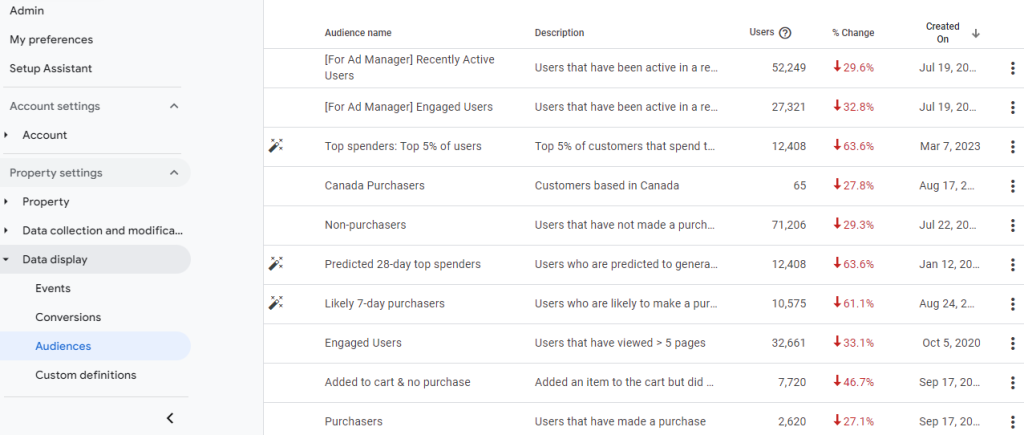
Building Your Audience Groups
GA4 lets you easily form these groups. For example, you might have one group that loves your how-to guides and another that can’t get enough of your behind-the-scenes videos. You can sort people based on what they watch, how often they visit, and even what kind of device they use.
Making Content for Each Group
Once you’ve got your groups sorted out, you can make content that’s just right for each one. This means you’re not just throwing out random posts and hoping they stick. You’re making stuff you know certain people will love because you’ve seen the patterns in what they enjoy.
Targeted Strategies for Better Reach
Knowing your audience segments means you can get really smart with how you reach out to them.
Maybe you’ll send special emails to the how-to lovers with more tips, or offer exclusive sneak peeks to the behind-the-scenes crowd. It’s all about making each part of your audience feel like you’re speaking directly to them.
Predictive Metrics and Analysis
GA4 isn’t just about looking at what’s already happened; it’s also about predicting what might happen next. This is super helpful for planning your future content and marketing strategies.
Understanding Predictive Analytics
Predictive analytics in GA4 uses patterns from past user interactions to estimate future actions. It can identify trends and predict which users are more likely to engage with your content or convert, allowing you to focus your efforts more effectively.
Planning with Predictions
With these insights, you can be one step ahead. If GA4 predicts that certain users are close to buying, you could send them a special offer to nudge them along. Or if it looks like they’re interested in a particular topic, you could create more content around that area.
Staying Ahead of the Curve
By using predictive metrics, you’re not just reacting to what’s already happened. You’re preparing for what’s to come, which can give you a big advantage in the busy online world. It’s about being proactive and making smart moves based on solid data.
Integration with Google Ads
GA4 effortlessly connects with Google Ads, forming a strong partnership that benefits content creators in several ways, including improved ad tracking and retargeting options.

Tracking Ad Performance
With GA4 and Google Ads working together, you gain deeper insights into how your ads are doing. You can easily track which ads attract more visitors, engagement, or actions like sign-ups or purchases, making it easier to use your ad budget wisely.
Understanding User Behavior
This integration lets you see how users interact with your content after clicking on an ad. You’ll know if they explore your website, view specific pages, or complete actions like signing up or making a purchase. This detailed info helps you adjust your content strategy for better results.
Retargeting Opportunities
GA4 allows you to create retargeting groups based on user interactions. For example, you can retarget users who visited your website but didn’t make a purchase, encouraging them to return and complete their desired actions.
Optimizing Ad Campaigns
By studying user behavior data from GA4, you can refine your ad campaigns. This means tweaking your ad designs, targeting options, and bidding strategies based on real user interactions, ultimately leading to more successful ad campaigns.
Smooth Data Flow
This integration ensures that data moves easily between GA4 and Google Ads, giving you a complete view of your advertising and content performance.
Conversion Tracking and Attribution
GA4 helps you unravel the mystery of how users become customers. It’s all about understanding the different steps people take on their journey towards taking action, whether it’s making a purchase, signing up, or any other important task.
Tracking the Conversion Path
GA4 paints a clear picture of the paths users follow to reach a conversion point. It’s not just about the last click before they convert; it’s about all the steps they take along the way. This means you can see which touchpoints contribute most to the final decision.
Attribution Models
Attribution is like giving credit where credit is due. GA4 uses various attribution models to distribute credit to different touchpoints. Some models give more credit to the first interaction, while others focus on the last click.
Data-Driven Insights
GA4 doesn’t rely on guesswork. It uses data-driven attribution, which means it looks at real data to figure out the true impact of each touchpoint. This can help you fine-tune your marketing strategies and allocate resources more effectively.
Multi-Channel Funnels
Users rarely convert after just one interaction with your content. They might first discover your website through an ad, then visit again from social media, and finally convert after receiving an email.
Multi-channel funnels in GA4 provide a comprehensive view of these customer journeys, so you can optimize your content for different touchpoints.
Customized Conversion Tracking
GA4 lets you define what a conversion means for your business. It’s not limited to purchases; you can track any action that matters to you, like form submissions, app installations, or video views. This flexibility ensures you’re measuring what’s most important.
Customizable Dashboards and Reports
GA4 offers a variety of customization options that help content creators build dashboards and reports tailored to their specific needs. Instead of going through piles of data, you can focus on the metrics and insights that matter most to you.

Creating Personalized Dashboards
With GA4, you can create personalized dashboards that display the metrics relevant to your content strategy. Whether you want to track user engagement, conversion rates, or traffic sources, you can arrange widgets and cards to show the information you care about.
Flexible Reporting
GA4’s reporting capabilities are flexible, allowing you to design reports that match your content goals. Whether you need daily, weekly, or monthly reports, you can schedule them for automated delivery to your inbox, ensuring you stay updated without manual effort.
Visualize Data Your Way
Visual representation of data is essential for understanding content performance. GA4 lets you choose from various visualization options, such as charts, graphs, and tables, to present data in a way that makes the most sense to you.
Share Insights Easily
Collaboration is important for content creators working in teams. GA4 enables you to share your dashboards and reports easily with team members or stakeholders, promoting collaboration and alignment toward content goals.
Efficient Decision-Making
By customizing dashboards and reports, you can streamline your decision-making process. You’ll have quick access to the insights you need, allowing you to make informed content decisions and adjustments promptly.
GA4 for E-commerce
If you’re running an online store, you know that understanding your customers is the key to selling more. But with all the data out there, it can feel like you’re trying to find a needle in a haystack. That’s where Google Analytics 4 (GA4) can help, making it easier for you to the insights that help you sell.
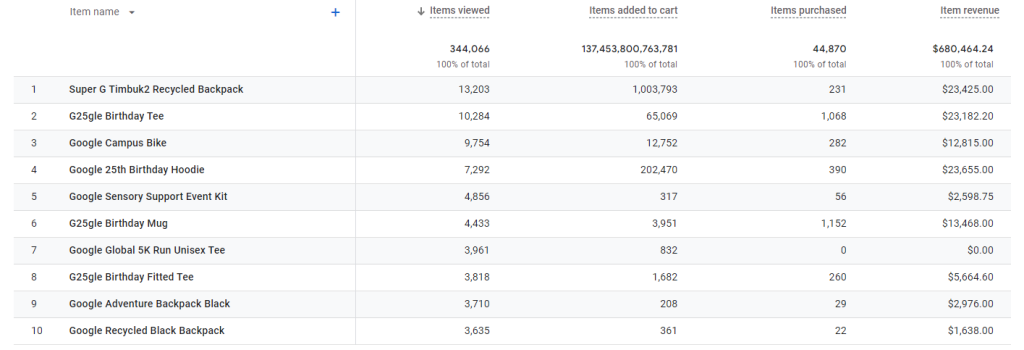
Track What Matters
GA4 lets you see which products are flying off the virtual shelves and which ones are gathering digital dust.
It’s like having a high-tech cash register that tells you more than just how much you made today. It tells you what products are popular, what times of day people are buying, and even what kind of devices they’re using to shop.
Understand Your Customers’ Shopping Habits
Imagine you could follow your customers around and see what they like. GA4 does that for you. It shows you the path customers take through your store.
You can see if they found you through a Google search, a social media post, or an ad somewhere else. You’ll learn what pages they looked at before deciding to buy, or what made them leave without buying anything.
Set Up Shop-Specific Events
In the world of GA4, an “event“ is any action that you think is important. For an e-commerce site, this could be when someone adds a product to their cart, starts the checkout process, or makes a purchase.
GA4 lets you set up these events easily, so you can track all the steps a customer takes on the way to buying something.
GA4 for Social Media Marketers
In the busy social media world, it’s crucial to know what catches people’s interest. GA4 helps social media marketers see the full picture, not just likes and shares. It tracks how people engage with your content on various platforms.
Track Your Social Success
Let’s say you’ve got a bunch of posts and ads out there on Facebook, Instagram, Twitter, and TikTok. GA4 helps you see which ones are hitting the mark. You can track which platform is sending the most visitors to your website and what they do once they get there.
Understand the Journey
GA4 doesn’t just tell you that someone clicked on your ad; it shows you what they did after that click. Did they look around your site? Did they sign up for your newsletter or download your e-book?
The platform connects the dots between your social media campaigns and your website’s activity, giving you a complete picture of the customer journey.
Conclusion
To sum it up, Google Analytics 4 (GA4) is a big help for content creators. You can see which parts of your work people enjoy the most and get ideas on how to keep them coming back.
GA4 is all about making sure you know your audience well. It helps you see not just how many people visit your site, but also what they do while they’re there. This helps you make better content that people really want to see.
So, if you’re making content and want to do a great job, getting to know GA4 is a smart choice. It’s there to help you make things that connect with people and stand out online. Use GA4 to get closer to your audience and make your content even better.
We at Goodish agency are experts in digital marketing and we can help you to utilize AI to reduce your costs and boost your performance. Read more about our services.


